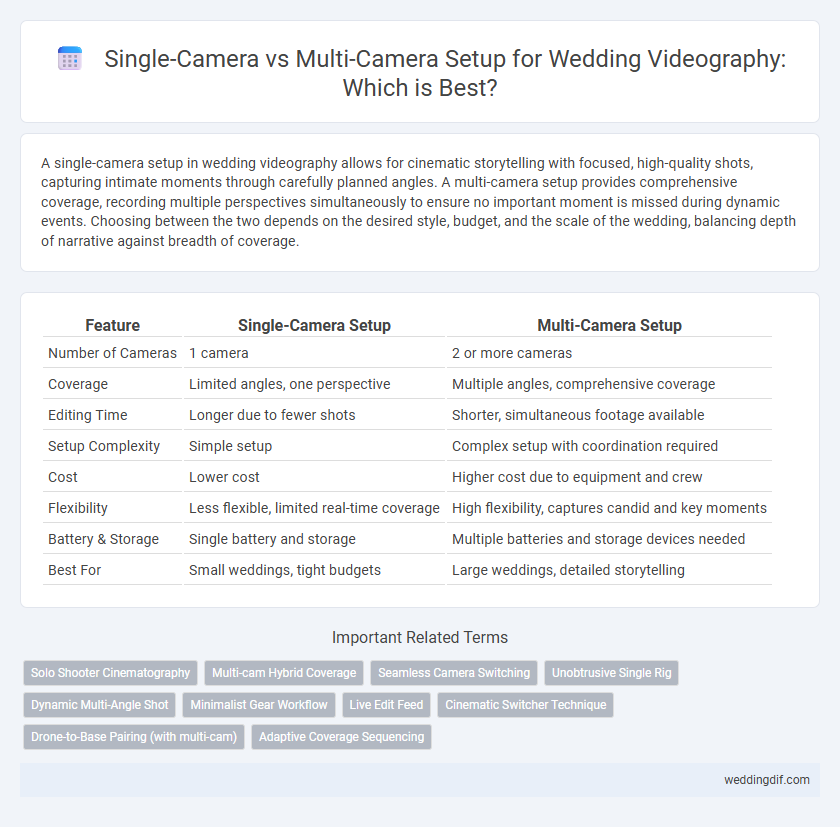A single-camera setup in wedding videography allows for cinematic storytelling with focused, high-quality shots, capturing intimate moments through carefully planned angles. A multi-camera setup provides comprehensive coverage, recording multiple perspectives simultaneously to ensure no important moment is missed during dynamic events. Choosing between the two depends on the desired style, budget, and the scale of the wedding, balancing depth of narrative against breadth of coverage.
Table of Comparison
| Feature | Single-Camera Setup | Multi-Camera Setup |
|---|---|---|
| Number of Cameras | 1 camera | 2 or more cameras |
| Coverage | Limited angles, one perspective | Multiple angles, comprehensive coverage |
| Editing Time | Longer due to fewer shots | Shorter, simultaneous footage available |
| Setup Complexity | Simple setup | Complex setup with coordination required |
| Cost | Lower cost | Higher cost due to equipment and crew |
| Flexibility | Less flexible, limited real-time coverage | High flexibility, captures candid and key moments |
| Battery & Storage | Single battery and storage | Multiple batteries and storage devices needed |
| Best For | Small weddings, tight budgets | Large weddings, detailed storytelling |
Introduction to Wedding Videography Setups
A single-camera setup in wedding videography offers focused, cinematic shots with precise control over framing and lighting, making it ideal for capturing intimate moments and artistic storytelling. Multi-camera setups provide comprehensive coverage by simultaneously recording multiple angles, ensuring no moment is missed and enabling dynamic editing options to showcase the entire event seamlessly. Choosing between setups depends on factors like event scale, budget, and desired video style, balancing coverage with cinematic quality.
What is a Single-Camera Setup?
A single-camera setup in wedding videography involves using one camera to capture all angles and moments sequentially, allowing for meticulous control over framing, lighting, and shot composition. This method enables a cinematic, story-driven approach with carefully crafted visuals and smooth transitions, ideal for intimate or smaller weddings. Single-camera setups require more time for shooting and editing but result in highly polished and artistic footage.
What is a Multi-Camera Setup?
A multi-camera setup in wedding videography involves using multiple cameras simultaneously to capture diverse angles and moments in real-time, providing a comprehensive and dynamic coverage of the event. This setup allows for continuous filming without missing critical reactions or interactions, enhancing the storytelling with varied perspectives. Wedding videographers often prefer multi-camera setups to ensure seamless editing and a more immersive final video experience.
Pros of Single-Camera Wedding Videography
Single-camera wedding videography offers a more cinematic and intimate storytelling approach, allowing videographers to focus on composition and lighting for each shot meticulously. This setup provides greater flexibility in capturing emotional close-ups and unique angles without the constraints of coordinating multiple cameras. It is often more cost-effective, making it an ideal choice for couples seeking high-quality, artistic wedding films within a limited budget.
Pros of Multi-Camera Wedding Videography
Multi-camera wedding videography captures diverse angles and spontaneous moments simultaneously, ensuring a comprehensive and dynamic portrayal of the event. This setup enhances post-production flexibility, allowing editors to create seamless transitions and highlight key emotions from multiple perspectives. Weddings filmed with multi-camera systems benefit from uninterrupted coverage, minimizing the risk of missing critical moments like vows, speeches, or first dances.
Cons of Single-Camera Wedding Coverage
Single-camera wedding coverage often results in limited coverage angles, restricting the ability to capture simultaneous moments. It increases the risk of missing key reactions or events, as the camera must be repositioned continuously. Moreover, post-production requires more time to assemble seamless footage from fewer sources, potentially delaying delivery.
Cons of Multi-Camera Wedding Coverage
Multi-camera wedding coverage often results in higher production costs due to the need for additional equipment and crew. Coordinating multiple angles can create challenges in maintaining consistent lighting and sound quality across all shots. This complexity increases post-production time, potentially delaying the delivery of the final wedding video.
Quality and Creative Differences
Single-camera setups in wedding videography offer greater artistic control, enabling filmmakers to capture nuanced emotions and unique angles with higher image quality per shot due to focused attention on one perspective. Multi-camera setups provide comprehensive coverage by simultaneously recording different moments and angles, ensuring no special moment is missed but may sacrifice some creative flexibility and consistent lighting. The choice between these setups impacts final video quality and storytelling style, with single-camera fostering cinematic storytelling and multi-camera emphasizing event completeness.
Budget Considerations for Camera Setups
A single-camera setup for wedding videography typically involves lower equipment and crew costs, making it ideal for budget-conscious couples. Multi-camera setups require higher investment due to multiple cameras, operators, and complex editing, but offer comprehensive coverage and varied angles. Choosing between setups hinges on balancing cost constraints with the desired footage quality and editing flexibility.
Choosing the Right Setup for Your Wedding
Choosing the right videography setup for your wedding depends on factors like venue size, budget, and desired coverage. Single-camera setups offer intimate, cinematic storytelling well-suited for smaller, more personal weddings, while multi-camera setups ensure comprehensive angles, capturing every moment in larger venues with multiple activities. Prioritize a multi-camera setup for dynamic editing options and full event coverage, or opt for a single-camera approach to emphasize creative, focused storytelling.
Single-camera setup vs Multi-camera setup for wedding Infographic

 weddingdif.com
weddingdif.com